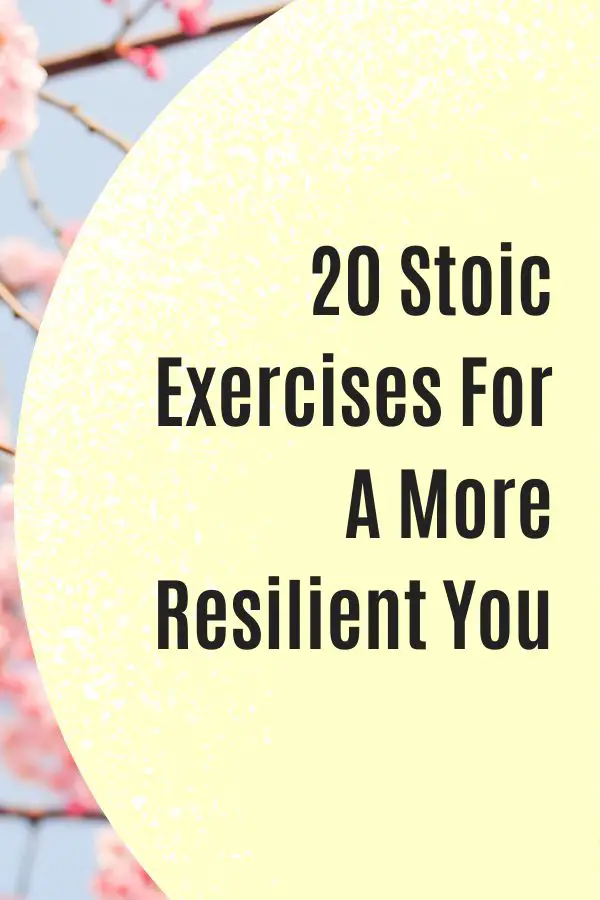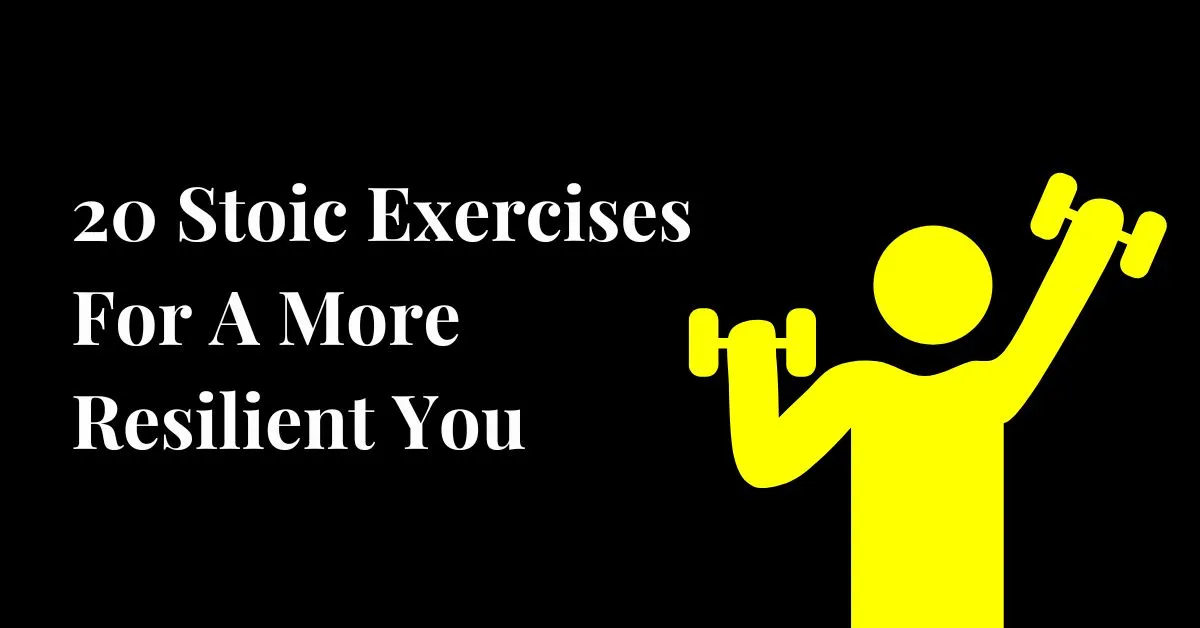The world today is full of distractions and uncertainties, which can make it difficult to focus on what is important to us. The Stoics recognized this challenge thousands of years ago and developed a philosophy that provides a practical and effective way to cultivate virtues such as wisdom, courage, justice, and self-control.
In this blog post, we will explore 20 unique Stoic exercises that you can start practicing today. These exercises are designed to help you develop the virtues that the Stoics believed were essential for a good life. Some of the exercises involve reflection and self-examination, while others involve practical actions that you can take in your daily life.

Table of Contents
Morning meditation
Starting your day with this stoic exercise is a powerful way to cultivate your Stoic virtues. This practice involves taking a few minutes each morning to focus your mind on these essential qualities and to set your intentions for the day ahead.
To begin your morning meditation, find a quiet and peaceful place where you can sit comfortably for a few minutes. Close your eyes and take a few deep breaths, allowing your mind and body to relax and become centered.
As you begin to focus, consider how you can embody each of the stoic virtues in your daily life. Ask yourself questions such as:
- How can I cultivate wisdom in my thoughts and actions today?
- In what ways can I show courage and resilience in the face of challenges?
- How can I act with justice and fairness towards others?
- What areas of my life can I practice self-control and restraint?
Negative visualization
To practice negative visualization, take a few moments each day to imagine a worst-case scenario in your life. This could be losing your job, experiencing a serious illness, or even losing a loved one.
Allow yourself to fully imagine the situation and all the emotions that come with it, such as fear, sadness, and uncertainty.
While this exercise may seem counterintuitive, it can actually be incredibly beneficial for developing resilience and a greater appreciation for what you have in your life.
Self-denial
By intentionally denying yourself of something that you want, you can train your mind and body to resist temptation and act in accordance with your values and goals.
To practice self-denial, choose something that you desire, but that is not essential to your wellbeing or happiness. This could be something as simple as a favorite food or drink, or something more challenging, such as social media or television.
Once you have identified what you will deny yourself of, set a specific time period for your self-denial. This could be for a day, a week, or even longer, depending on the challenge you want to set for yourself.
Pay attention to the thoughts and emotions that arise. You may feel a sense of discomfort or even frustration, as your mind and body adjust to the absence of the thing you desire. However, by persisting through this discomfort, you can develop greater self-discipline and a sense of control over your desires.
The discipline of social relations
This discipline involves practicing empathy and understanding, putting ourselves in others’ shoes and seeing things from their perspective. It also involves recognizing our own limitations and biases, and being open to feedback and criticism. By cultivating positive social relations, we can strengthen our bonds with others and create a more harmonious and just society.
Inner dialogue
This stoic exercise involves having an honest and reflective conversation with yourself about your values and beliefs. By engaging in this exercise, you can develop greater self-awareness and insight into your thoughts and actions, as well as a deeper understanding of your core values and beliefs.
To practice inner dialogue, find a quiet and peaceful place where you can be alone with your thoughts. Take a few deep breaths to calm your mind and focus your attention inward.
Begin by asking yourself a series of questions about your values and beliefs. These could include questions such as:
- What are my core values and beliefs?
- How do my actions align with my values and beliefs?
- What are the areas in my life where I need to improve?
- What steps can I take to live a more meaningful and fulfilling life?
As you reflect on these questions, allow yourself to be honest and open with yourself. Acknowledge any areas where you may be falling short or struggling to live in accordance with your values, and explore potential solutions or steps you can take to improve.
The discipline of desire
Examine your desires and attachments, and ask yourself whether they are in accordance with reason and virtue. If a desire is in alignment with these principles, you can pursue it with intention and purpose. However, if a desire is not in accordance with reason and virtue, you can seek to detach from it, and focus instead on cultivating inner virtues and qualities.
Momentary mindfulness
Find a quiet and peaceful place where you can take a few moments to yourself. You can also practice this exercise in the midst of your daily activities, such as when you’re standing in line or waiting for an appointment.
Begin by taking a few deep breaths, focusing your attention on the sensation of the breath moving in and out of your body. As you breathe, allow yourself to let go of any distractions or concerns that may be occupying your mind, and simply be present in the moment.
You may also want to pay attention to your surroundings, noticing the sights, sounds, and sensations around you. Allow yourself to fully immerse in the present moment, without judgment or attachment to any particular thoughts or emotions.
Premeditation of adversity
Begin this stoic exercise by reflecting on your goals and aspirations. Ask yourself what obstacles or challenges you might encounter in pursuing these goals, and imagine them as vividly as possible.
For example, if your goal is to start a new business, you might imagine scenarios such as a lack of funding, difficulty finding customers, or unexpected setbacks in the development process. Allow yourself to fully immerse in these scenarios, imagining how you would feel and how you might respond.
As you visualize these scenarios, take note of any potential solutions or strategies that you could use to overcome these obstacles. You may also want to reflect on your own strengths and weaknesses, and how they might impact your ability to navigate these challenges.
The discipline of endurance
To practice the discipline of endurance, start by identifying a challenging situation or goal that you are currently facing or pursuing. This could be a difficult work project, a personal relationship issue, or a physical fitness goal, for example.
Next, focus on developing a mindset of perseverance and resilience. Recognize that setbacks and obstacles are a natural part of any challenging pursuit, and that they can be opportunities to learn and grow. Reframe your mindset to view challenges as opportunities for growth and development, rather than as threats or failures.
As you encounter difficulties and setbacks, practice staying committed to your goal and maintaining your focus and motivation. Embrace the discomfort and push through the pain, knowing that you are building mental and emotional strength with every step.
View from above
Find a quiet place where you can sit or lie down comfortably. Close your eyes and take a few deep breaths to help calm your mind. As you begin to relax, imagine yourself rising up higher and higher until you’re looking down on your life from above.
From this elevated perspective, allow yourself to see your life as a whole, and observe the patterns and rhythms that emerge. Try to view your life objectively, without judgment or emotion, and simply observe the different aspects of your life, such as your work, relationships, and personal goals.
As you continue to observe your life from this higher perspective, reflect on your values and priorities, and how they align with your actions and goals. Consider the different paths you could take, and which ones would be most aligned with your values and purpose.
Contemplation of the cosmos
This Stoic exercise involves reflecting on the vastness and complexity of the universe in order to gain a sense of perspective and humility. It can help you recognize the smallness of your individual problems and concerns, and gain a greater appreciation for the interconnectedness of all things.
Find a quiet place where you can sit or lie down comfortably. Close your eyes and take a few deep breaths to help calm your mind. As you begin to relax, imagine yourself floating in space, surrounded by the vast expanse of the universe.
As you contemplate this stoic exercise, consider the many mysteries and wonders that exist beyond our understanding. Reflect on the fact that everything in the universe is interconnected, from the smallest particle to the largest galaxy.
Try to let go of your individual concerns and ego, and recognize the smallness of your own problems in comparison to the vastness of the universe. Allow yourself to feel a sense of awe and wonder at the immensity of existence, and recognize the inherent interconnectedness of all things.
The discipline of attention
What is most important to you in your life right now? What do you want to achieve or focus on in the short-term and long-term? Once you have identified these priorities, make a conscious effort to focus your attention on them, while minimizing distractions and trivialities.
This may involve setting boundaries with your time and energy, such as limiting your use of social media or avoiding non-essential tasks and activities. It may also involve developing a mindfulness practice, such as meditation or deep breathing exercises, to help you stay focused and centered in the present moment.
The dichotomy of control
To practice the Dichotomy of Control, start by making a list of the things in your life that are within your control, such as your thoughts, beliefs, and actions. These are the things that you have direct influence over, and that you can work to change or improve.
Next, make a separate list of the things in your life that are outside of your control, such as the actions of others, the weather, or unforeseen events. These are things that you cannot directly influence, and that you may need to accept and adapt to.
Once you have identified the things that are within and outside of your control, focus your energy and attention on the former. By working to improve the things that are within your control, you can create positive change in your life and cultivate a sense of agency and empowerment. At the same time, try to let go of the things that are outside of your control, and recognize that they are simply part of the natural ebb and flow of life.

The discipline of assent
Start this stoic exercise by cultivating a sense of mindfulness and awareness of your thoughts and beliefs. When a thought or belief arises in your mind, take a moment to examine it critically, and ask yourself whether it is in accordance with reason and virtue.
If the thought or belief is in accordance with reason and virtue, you can give it your assent, and allow it to guide your actions and behaviors. However, if the thought or belief is not in accordance with reason and virtue, you can reject it, and seek to replace it with a more rational and virtuous perspective.
The discipline of action
This involves training yourself to act in accordance with reason and virtue. This means learning to align your actions and behaviors with the principles of Stoic philosophy, and cultivating a deep sense of personal integrity and responsibility.
To practice this stoic exercise, start by examining your actions and behaviors, and ask yourself whether they are in accordance with reason and virtue. If an action is in alignment with these principles, you can pursue it with intention and purpose. However, if an action is not in accordance with reason and virtue, you can seek to modify or correct it, and strive to act in a way that is more aligned with your values and beliefs.
The discipline of perception
This stoic exercise involves training yourself to see things objectively, rather than through the lens of your emotions. This means learning to detach yourself from your emotions and biases, and approaching situations with a clear and rational mindset.
Explore your thoughts and emotions, and ask yourself whether they are clouding your judgment. If you find yourself becoming emotional or reactive in a situation, take a step back and try to detach yourself from your emotions. Look at the situation objectively, and try to see it from a rational and logical perspective.
The discipline of will
Set challenging but achievable goals for yourself, and work towards them with determination and focus. When faced with obstacles or setbacks, don’t give up or become discouraged. Instead, look at these challenges as opportunities to learn and grow, and use them as motivation to keep moving forward.
The discipline of judgment
Start by examining your thought processes and identifying any biases or emotional attachments that may be clouding your judgment. Then, consider the situation at hand from a rational and objective perspective, and weigh the potential consequences of different courses of action. Finally, make a decision based on what is virtuous and in accordance with reason, rather than what is simply expedient or emotionally satisfying.
The discipline of gratitude
To practice this stoic exercise, take some time each day to reflect on the good things in your life. This could be anything from a beautiful sunset, to a kind gesture from a friend, to the fact that you have a roof over your head and food to eat. Whatever it is, take a moment to savor and appreciate it, and feel a sense of thankfulness for the experience.
The discipline of humor
This stoic exercise emphasizes the importance of taking a lighthearted and humorous approach to life’s challenges and difficulties. It involves learning to laugh at oneself and one’s circumstances, rather than taking everything too seriously or personally.
Stoics believe that humor can help us maintain a sense of perspective and avoid getting bogged down by negative emotions like anger, anxiety, or despair. By learning to see the humor in a situation, we can defuse tensions, connect with others, and find creative solutions to problems.
At the same time, Stoics caution against using humor to dismiss or belittle the suffering of others or to avoid confronting serious issues. The discipline of humor is not about making light of the world’s problems or denying the reality of pain and hardship. Instead, it is about finding a healthy balance between seriousness and levity, and using humor as a tool for growth and self-improvement.
Conclusion
The Stoic exercises we have explored in this blog post offer a practical and effective way to integrate Stoic philosophy into our daily lives.
From morning meditations to contemplation of the cosmos, these exercises help us cultivate virtues such as wisdom, courage, justice, and self-control, which are essential for living a meaningful and fulfilling life.
By practicing these exercises regularly, we can develop a greater sense of resilience, focus, and humility in the face of life’s challenges.
So, if you are looking for a way to improve your mental and emotional well-being, give these Stoic exercises a try. Remember, Stoicism is not just a philosophy but a way of life, and with practice, we can all become better versions of ourselves.

